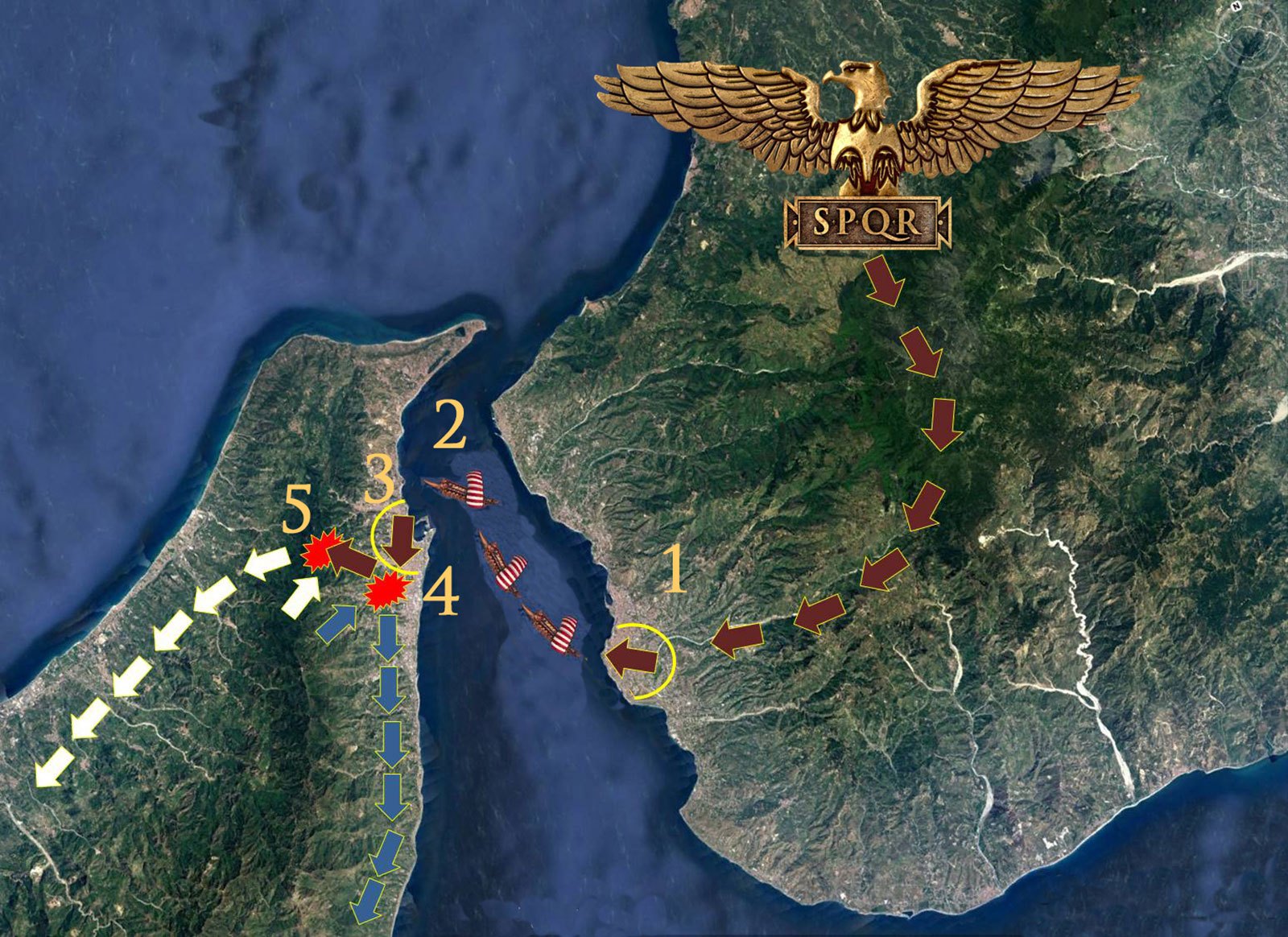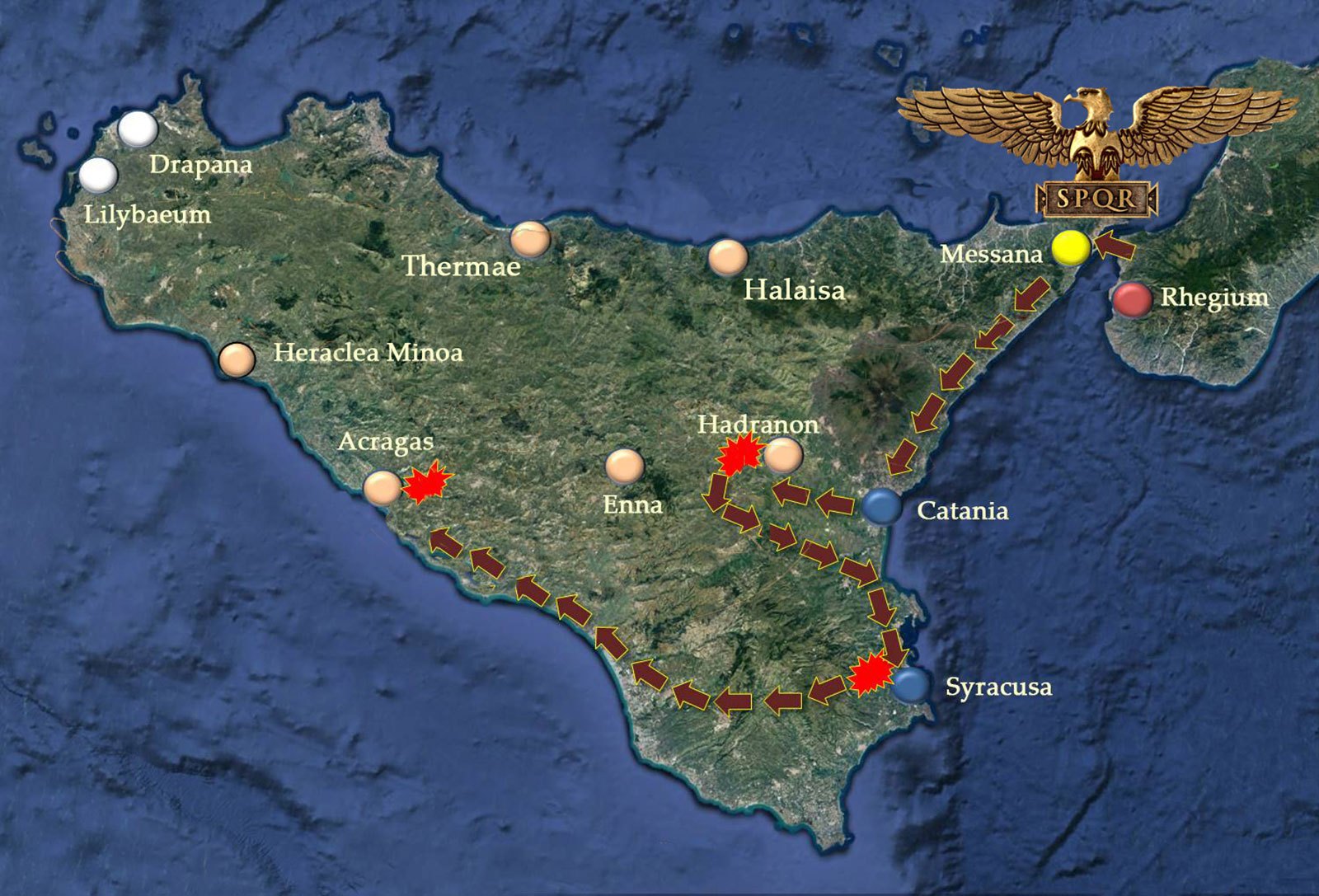First Punic War—264-241 BC
Phase 1: Opening Round, 263-261 BC
Punic War Phase 1: Roman army Defeats Syracusans and Carthaginians at Messana
- Roman army marches to Rhegium
- Crosses the straits of Messana under command of the consul Appius Claudius Caudex
- Reinforces Messana
- Beats the Syracusan army causing it to abandon the campaign
- Defeats Carthaginians, causing them to retreat
In 263 BC, a Roman Consular Army (approximately 20,000 men) under the Consul Appius Claudius Caudex, lands near Messana, and drives off the Syracusan and Carthaginian forces investing the town. Claudius leaves a strong garrison in Messana and returns with his army to Italy. Thus the Romans achieve their war aim; preservation of Mammertine independence and establish a strategic Roman presence in Sicily.
1st Punic War: Roman Successes in 262 BC
In the second year of fighting, a consular army crossed the strait of Messana then marched south and took Hadranon. It then besieged Syracusa, failed to take the town, nevertheless, caused it to switch sides; a strategic success. The Romans then invested Acragas, a forward base for the Carthaginians, and bottled up a Carthaginian garrison there. A Carthaginian relieving force was sent which the Romans defeated.
The following year, 262 BC, Consuls L. Postumius Megellus and Q. Mamilius Vitullus bring two additional legions and take command of Roman forces in Sicily. They march down the eastern coast of Sicily, turn inland and take Haranon and Kentoripa along the way, then return to the coastal road and besiege Syracuse. There is no hope of taking the city. The Carthaginians don’t have adequate forces in Sicily to come to their ally’s aid, but the Roman presence makes enough of an impression for Syracuse to switch sides.
Thus in a single stroke, the Romans flip the strategic balance of power on the island, detaching a regional power from Carthage. Furthermore, with such a large and irresistible force on the island, 67 cities make an accommodation with Rome. With the Eastern coast of Sicily under her control, Rome marches on Acragas (Agrigentum), a Carthaginian ally and the second most powerful city on the island.
The Siege and Sack of Acragas
Acragas has a Carthaginian garrison defending the town against the Roman army. In the meantime, the Carthaginians raise a mercenary army of approximately 50,000 infantry, 6,000 cavalry and 60 elephants which lands at Lilybaeum and marches on Acragas to break the siege. The Romans meet this relieving force in the field and defeat it. The Romans plunder the Carthaginian camp. Distracted by their victory, the Romans allow the Carthaginian garrison to quit the city. They leave the citizens of Acragas to face the Romans on their own. The Romans plunder the city and sell the entire population into slavery.
Caven, B. The Punic Wars. Barnes & Noble Books. USA. 1992.
Bagnall, N. The Punic Wars. 264-146 BC. Osprey Publishers Limited. Oxford, England.
Polybius. The Rise of the Roman Empire (Classics) (Trans. Ian Scott-Kilvert) (Kindle Locations 793-794). Penguin Books Ltd. Kindle Edition.
Success in the Field Causes the Romans to Change Their War Aim
Its stunning success in the opening phase of the war causes the Roman Senate to shift its goal from preserving a presence in Sicily by ensuring the survival of its ally, the Mamertines, to clearing the Carthaginians from the island completely. After the victory at Acragas, many Sicilian cities come over to the Roman side. The Carthaginian navy, however, ensures that those along the coast remain loyal to Carthage.
Roman losses are too great for them to keep the initiative on land. The Roman army under the leadership of the Consuls L. Postumius Megellus and Q. Mamilius Vitullus in 262 BC, winter at Messana. The following spring, two new Consuls—L. Valerius Flaccus and T. Otacilius Crassus—take command of what is left of Roman forces in Sicily.
The year 261 BC sees a shift in Carthaginian strategy, from one that is land based to one that is primarily naval. The Carthaginians maintain their garrisons in various Sicilian cities and avoid set-piece land battles with the Romans. The Carthaginian fleet supplies its allies in case of seige. The Roman initiative of the first two years is lost. With the outcome less promising than before, Rome’s Sicilian allies, with the exception of Syracuse, begin to waver.
Bagnall N. Essential Histories. The Punic Wars 264-146 BC. Osprey Publishing Ltd. London 2002.
In order to achieve its new war aim, the Roman Senate realizes that it must replenish its depleted army in Sicily. It must also build a navy in order to offset the impact of the Carthaginian navy on the Sicilian coastal cities. To that end, it raises another consular army to continue the fight in Sicily. At the same time, it begins building a fleet of 120 ships (100 quinqueremes and 20 triremes) that can compete with the Carthaginians at sea.


